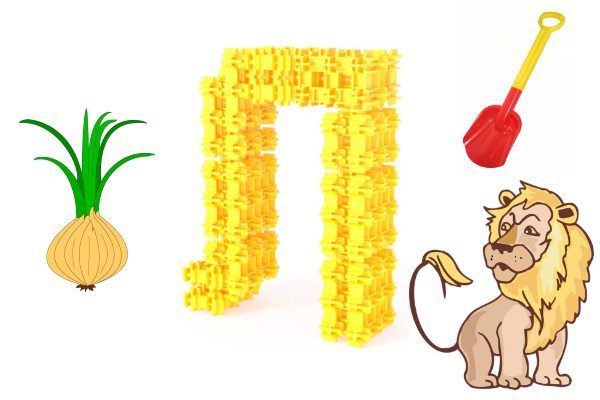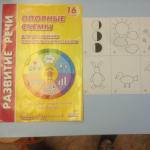Setting the correct sound "L" in a child
One of the latest sounds that a child begins to pronounce is "L". Sometimes it is possible to put his pronunciation only by the age of 6. There are a number of exercises that can help with this. It is important to know the correct technique for their implementation, so as not to worsen the situation with articulation. It can take a long time to produce the "L" sound, so it's important to take your time and work out consistently.

The incorrect pronunciation of "L" and "L" has its own name - lambdacism. This term describes not only the incorrect reproduction of sound, but also its complete skipping. Lambdacism is of several types:
- bilabial: instead of the correct sound, “y” is heard (“uapata” instead of “shovel”);
- nasal (the root part of the tongue falls on the soft palate, due to which the air flow rushes into the nose, the sound “l” changes to “ng” - instead of the word moon, “nguna” can be heard).
- interdental (in the process of speech, the tip of the tongue is placed in the interdental space);
- Sometimes the sound is not pronounced at all (instead of the word onion, the child says "uk").
Another speech therapy term describes the condition when a child replaces the correct sound "l" with others - paralambdacism. More often in practice, such substitutions "l" occur:
- on G - "stack" instead of "table", instead of "floor" "pogy";
- on B - instead of "ski" "survive";
- on Yo - instead of the word "spoon" pronounced "hedgehog":
- on D - the word "horse" is pronounced as "doshad";
- to the soft sound L - “dividing instead of“ deeds ”.
With the right exercise, this can be corrected.
What are the reasons for the incorrect pronunciation of "L"
There are only 3 reasons why a child may not learn how to pronounce "L" correctly right away. Among them:
- in the course of a conversation, "L" is not perceived by the child phonemically;
- anatomically short hyoid ligament;
- weakness of the muscles of the tongue.
Sometimes the age of the baby is also attributed to the reasons - if the child is very small (2-3 years old), his mistakes in pronouncing "L" can be considered the norm, since the sound is formed later - by 4-6 years.
How to position the tongue and lips to correctly pronounce "L"
The pronunciation of "L", especially if the sound is not yet obtained, requires the correct location of the organs of articulation. You need to pay attention to the following rules:
- teeth from the upper and lower rows should not close - it is better if they are at a small distance from each other;
- in order not to disrupt breathing, it is important to monitor the lateral parts of the tongue - they should not adjoin the far teeth of the upper row;
- the tip of the tongue should be strained, it should rest against the upper teeth or the gums above them;
- it is important to lift the root part of the tongue;
- in order for the passage to the nasal cavity to be closed, it is necessary to raise the upper palate;
- vibration must be created in the area of the vocal cords.
The position of the lips can be different when pronouncing "L" - it all depends on the letters that follow in the word after.
What can be mistakes when trying to pronounce "L"
There are several common mistakes that occur when trying to pronounce "L". In this case, all methods of staging sound become ineffective. Many of the errors are caused by misalignment of the lips and tongue and are therefore easy to fix.
The sound "L" may not work due to the fact that:
- the tongue is pulled into the inside of the mouth, which makes it possible to pronounce "Y" (instead of the word "crowbar" it turns out "yom");
- lips are not positioned correctly, which causes the wrong sounds to be heard - for example, the combination “uva” (instead of “shovel” “uvapata”);
- a sharp breath is taken at the moment of pronunciation - L changes to F if the cheeks are involved, and to H if the air flow passes through the nose.
Sometimes children replace the sound “L” with “R” - this happens especially often if the last sound has already been worked out, but the first one has not. Then the child can say "ruk" instead of "bow".
Incorrect lip placement
If bilabial lambdacism is present, errors may be associated with incorrect positioning of the lips during pronunciation - for example, if the baby pulls them out strongly, instead of the desired sound, “y” or “v” is obtained.
The “Smile” exercise is especially useful here: you need to clench your teeth, and your lips should be strongly parted in a smile. This position should be maintained as long as possible, and it is better to perform the movement under the count. Sometimes adults even have to hold their lips in such a smile manually to avoid pulling them out.

So that the baby does not strain his lips when doing exercises on "L", you can do the following tasks:
- "Fish": relax your lips, and then pat them together, like aquarium fish.
- "Fatigue": take a deep breath through the nose, and exhale through the mouth: while the lips should be parted and relaxed.
- "Horse": you need to inhale through the nose, and exhale through the mouth. At the same time, the lips should be relaxed so that their “prr” vibration begins from the air flow.
Preparation for the exercises for setting "L"
There is articulatory gymnastics that helps to put "L" and facilitates the process of setting the sound later. In general, exercises help increase the mobility of the lips and tongue:
- "Hammock" - the tip of the tongue rests on the front incisors of the upper row. It should be bent down so that it resembles a hammock sagging down in shape. There is no need to perform any movements here - just hold the tongue in this position for a while. It is better to do the exercise on the account.
- “Delicious” - the tongue must be made wide, and then lick the upper lip with it from top to bottom. It is important that the tongue works independently - the lower lip should not move up, thus moving the tongue. This makes it easier to do the exercise, but it's wrong.
- "Turkey" - the position of the tongue, as well as the movements performed, coincide with the "Tasty" exercise. At the same time, it is necessary to significantly speed up the pace of movements and add to this the pronunciation of the sound “bl-bl-bl” or similar.
- "Horse" (helps if it is difficult to hold the tongue on weight, resting it on the front teeth): the tongue should be made wide, and then clicked on the sky near the upper front teeth. The lower jaw should not move in any way, and the mouth should be slightly opened.
- "Swing" - in a wide smile you need to open your mouth. The exercise is performed according to the account - for “one” you need to rest the tip of the tongue against the upper teeth from the inside, for “two” - in the lower ones. The exercise is performed alternately.
- "Fungus" (helps to fix the tongue on the palate, that is, in the position on top): the surface of the tongue from above must be rested against the palate so that the tension of the tongue frenulum is felt. Movement is not required.
Such exercises are effective for any type of lambdacism. Prior to the start of training directly "L", these exercises must be performed for at least 14 days (sometimes such training is continued for a whole month). After that, you can start doing speech therapy exercises for the sound that is needed.
You can find more details on our website.
Training the sound "L" by imitation
If the child does not pronounce the sound in any way, it will be easier to put it in, because replacing the right sound with the wrong one forms a habit, and it can be much more difficult to correct it.
You can learn to speak hard and soft "L" by imitating the correct sound. At the same time, you need to show the child how to properly position the articulatory organs in order to be able to pronounce "L". They do this in front of a mirror - a speech therapist or a parent sits down to him with a child and, by his own example, shows the correct position of the lips and tongue when pronouncing "L".

In words, this can be explained as follows: the tongue should be expanded as much as possible, and the tip should be pressed to the base of the upper front teeth. The middle part of the tongue needs to be bent down, like a hammock, and the root, on the contrary, should be raised. It is important not to lift the lateral parts of the tongue up, because otherwise the air flow will not rush in the right direction - to the cheeks (they vibrate if you touch them while pronouncing the sound).
Such a setting of the sound “L” from demonstrating their example is effective, but children, due to their small age, cannot always understand and repeat it. Then you can pick up simpler tasks - for example, tell the child fairy tales that train the necessary sounds (you usually need to extend these sounds in them, for example, if the fairy tale is about steamboats, you can imitate the sounds “LLL” they make).
The child may not immediately learn how to pronounce “L” correctly, but after several trainings, the desired sound should turn out. For the sound “L”, articulatory gymnastics is carried out both through exercises for the language and through the pronunciation of syllables and words.
When you manage to train "L", you can try to combine it with vowels and pronounce syllables already - Lo, La, Le and others. If the baby has difficulties with such combinations, you can start with the reverse ones - Ol, Al, Ul.
How to make correct pronunciation automatic
Staging at home can be very difficult. This is a long process, so it is better not to overload the child - it is enough to practice for a few minutes 2 times a day (no longer than half an hour). It is better to conduct training in a playful way.
Soft "L"
Even if the child has learned to speak the sound “L” itself, as well as the syllables with its participation, he can still miss it in words. Then it is better to start with training the soft sound "L". Here, too, you should start training with syllables - La, Liu, Li and other similar ones. When the syllables begin to turn out, you can try to go to the words:
- Le: light;
- La: fields;
- Le: laziness;
- Liu: buttercup;
- Lee: fox.
The production of the sound "L" in individual words can be fixed with pure words:
- La-la-la - cold earth.
- Lu-lu-lu - I'll flood the stove.
- Li-li-li - we found mushrooms.
Tongue twisters are also useful. For example, to set the sound "L" you can use the following:
- Lala ate halva under the covers.
- At the warm stove, Tolya weaves bast shoes.
- Lyuba loves buttercups, and Polya loves cartoons.
- Barely Lena ate, she didn’t want to eat out of laziness.
- Valenki felt boots are small for the giant.
If in syllables of the direct type the articulation of the sound "l" of the soft began to turn out, you can go to the reverse ones. The syllables are pronounced as follows: Al, Yel, Ol, Yal, Ul, etc. After setting them, you can also switch to the corresponding words - for example, tulle, poplar, moth, tulip, high chair.
Sound combinations can be complicated by adding additional consonants - K, P, F, G, S (Slyu, Slya, Sli, etc.). Words for staging such sounds are easy to pick up - plum, cranberry, slush, glucose, flux, mica, plus and others).
The following exercises for setting L will help to consolidate the skill:
- FIR-EL-EL: in the yard drops.
- OL-OL-OL: the moth flew.
- YL-YL-YL: palm quickly lathered.
- UL-UL-UL: we will hang the tulle.

You can play this game. Connect objects with squares depending on where the letter "l" occurs (at the beginning, at the end or in the middle). Say each item several times.
At this stage, you still need to control the correct position of the tongue in the mouth.
Solid "L"
It is more difficult to learn to pronounce "L" solid. The technique here is similar to that used when the articulation of the sound "L" is put, but much more repetitions may be required.
It is better to start with solid syllables - La, Lo, Lu, Ly, Le. When you manage to put them, you can go to the words:
- Lo: boat, elbow, forehead;
- La: lamp, bench, varnish;
- Ly: skis, floors, tables;
- Lou: moon, meadow, bow.
To consolidate the result, such tongue twisters and tongue twisters are suitable:
- La-la-la - removed the garbage,
- Lu-lu-lu - sweep the ashes,
- Lo-lo-lo - the glass burst.
- In the boat Volodya.
- Put coal in the corner.
- Near London is the lair of the sorcerer.
When setting "L" hard and soft, it is better to avoid words or syllables with "R". The sounds "L" and "R" are especially difficult for a child, so it's best not to confuse them with each other. required later than "L".
The sound "L" is one of the most complex sounds, which in some cases can be formed only by 6 years. To put it as quickly and efficiently as possible, it is better to consult with a speech therapist. You can try to cope at home with the help of exercises.






